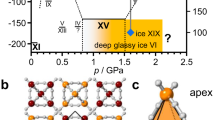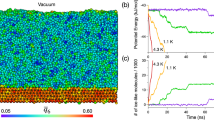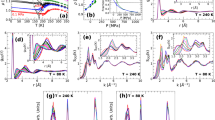Abstract
On being heated, ice melts into liquid water. Although in practice this process tends to be heterogeneous, it can occur homogeneously inside bulk ice1. The thermally induced homogeneous melting of solids is fairly well understood, and involves the formation and growth of melting nuclei1,2,3,4,5. But in the case of water, resilient hydrogen bonds render ice melting more complex. We know that the first defects appearing during homogeneous ice melting are pairs of five- and seven-membered rings, which appear and disappear repeatedly and randomly in space and time in the crystalline ice structure6,7,8. However, the accumulation of these defects to form an aggregate is nearly additive in energy, and results in a steep free energy increase that suppresses further growth. Here we report molecular dynamics simulations of homogeneous ice melting that identify as a crucial first step not the formation but rather the spatial separation of a defect pair. We find that once it is separated, the defect pair—either an interstitial (I) and a vacancy (V) defect pair (a Frenkel pair), or an L and a D defect pair (a Bjerrum pair)9—is entropically stabilized, or ‘entangled’. In this state, defects with threefold hydrogen-bond coordination persist and grow, and thereby prepare the system for subsequent rapid melting.
This is a preview of subscription content, access via your institution
Access options
Subscribe to this journal
Receive 51 print issues and online access
$199.00 per year
only $3.90 per issue
Buy this article
- Purchase on Springer Link
- Instant access to full article PDF
Prices may be subject to local taxes which are calculated during checkout




Similar content being viewed by others
References
Iglev, H., Schmeisser, M., Simeonidis, K., Thaller, A. & Laubereau, A. Ultrafast superheating and melting of bulk ice. Nature 439, 183–186 (2006)
Fecht, H. J. Defect-induced melting and solid-state amorphization. Nature 356, 133–135 (1992)
Cahn, R. W. Materials science: Melting from within. Nature 413, 582–583 (2001)
Forsblom, M. & Grimvall, G. How superheated crystals melt. Nature Mater. 4, 388–390 (2005)
Jin, Z. H., Gumbsch, P., Lu, K. & Ma, E. Melting mechanisms at the limit of superheating. Phys. Rev. Lett. 87, 055703 (2001)
Tanaka, H. & Mohanty, J. On the Debye-Waller factor of hexagonal ice: a computer simulation study. J. Am. Chem. Soc. 124, 8085–8089 (2002)
Grishina, N. & Buch, V. Structure and dynamics of orientational defects in ice I. J. Chem. Phys. 120, 5217–5225 (2004)
Donadio, D., Raiteri, P. & Parrinello, M. Topological defects and bulk melting of hexagonal ice. J. Phys. Chem. B 109, 5421–5424 (2005)
Bjerrum, N. Structure and properties of ice. Science 115, 385–390 (1952)
McBride, C., Vega, C., Sanz, E., MacDowell, L. G. & Abascal, J. L. F. The range of meta stability of ice-water melting for two simple models of water. Mol. Phys. 103, 1–5 (2005)
Bernal, J. D. & Fowler, R. H. A theory of water and ionic solution, with particular reference to hydrogen and hydroxyl ions. J. Chem. Phys. 1, 515–548 (1933)
Petrenko, V. F. & Whitworth, R. W. Physics of Ice (Oxford Univ. Press, 1999)
Abraham, F. F. Homogeneous Nucleation Theory: The Pretransition Theory of Vapor Condensation (Academic, 1974)
Wales, D. Energy Landscapes: Applications to Clusters, Biomolecules and Glasses (Cambridge Univ. Press, 2004)
Henkelman, G., Uberuaga, B. P. & Jonsson, H. A climbing image nudged elastic band method for finding saddle points and minimum energy paths. J. Chem. Phys. 113, 9901–9904 (2000)
Matsumoto, M., Baba, A. & Ohmine, I. Topological building blocks of hydrogen bond network in water. J. Chem. Phys. 127, 134504 (2007)
Matsumoto, M., Saito, S. & Ohmine, I. Molecular dynamics simulation of the ice nucleation and growth process leading to water freezing. Nature 416, 409–413 (2002)
Jacobson, L. C., Hujo, W. & Molinero, V. Amorphous precursors in the nucleation of clathrate hydrates. J. Am. Chem. Soc. 132, 11806–11811 (2010)
Walsh, M. R., Koh, C. A., Sloan, E. D., Sum, A. K. & Wu, D. T. Microsecond simulations of spontaneous methane hydrate nucleation and growth. Science 326, 1095–1098 (2009)
Moore, E. B. & Molinero, V. Structural transformation in supercooled water controls the crystallization rate of ice. Nature 479, 506–508 (2011)
Jorgensen, W. L., Chandrasekhar, J., Madura, J. D., Impey, R. W. & Klein, M. L. Comparison of simple potential functions for simulating liquid water. J. Chem. Phys. 79, 926–935 (1983)
Jorgensen, W. L. & Madura, J. D. Temperature and size dependence for Monte-Carlo simulations of TIP4P water. Mol. Phys. 56, 1381–1392 (1985)
Vega, C., Sanz, E. & Abascal, J. L. F. The melting temperature of the most common models of water. J. Chem. Phys. 122, 114507 (2005)
Jacobson, L. C., Hujo, W. & Molinero, V. Thermodynamic stability and growth of guest-free clathrate hydrates: a low-density crystal phase of water. J. Phys. Chem. B 113, 10298–10307 (2009)
Nose, S. Constant-temperature molecular dynamics. J. Phys. Condens. Matter 2, SA115–SA119 (1990)
Frenkel, D. & Smit, B. Understanding Molecular Simulation: From Algorithms to Applications (Academic, 2002)
Acknowledgements
We thank D. J. Wales, N. Kosugi, H. Tanaka and S. Saito for their support and advice, and T. Yagasaki for performing the free-energy calculation to determine the melting temperature. Some of the calculations were carried out at the Research Center for Computational Science of NINS, Okazaki, Japan.
Author information
Authors and Affiliations
Contributions
K.M. performed the simulations and carried out data analysis. M.M. developed the methods and carried out data analysis. All authors designed the study, discussed the results and contributed to writing the paper.
Corresponding author
Ethics declarations
Competing interests
The authors declare no competing financial interests.
Supplementary information
Supplementary Information
This file contains Supplementary Figures 1-9, Supplementary Methods, a Supplementary Discussion, Supplementary Table 1 and additional references. (PDF 4200 kb)
Local density of ice melting
This video shows the successive transformation of Voronoi polyhedron along the trajectory of Figure 1.Voronoi tessellation is applied to show the volume occupied by each water molecule. The Voronoi polyhedra that have more than 5% larger (5% smaller) volume than the average volume are gradated in blue (red). Polyhedra with thickest colors have more than 10% higher or lower local volume than the average. At around 2150ps when many off-lattice molecules are accumulated in a locus (form a cluster), inside of which the density fluctuation is observed. Then, at 2210 ps, this cluster is separated into the high-density region (I-defect region, red) and the low-density region (V-defect region, blue). (MP4 25798 kb)
Local structure of ice melting
This video shows the local HB structure change along the trajectory of Figure 1. Fragments are used to show the local HB structures; eight typical interfacial fragments of (a)~(h) in Supplementary Figure 5 are colored with from red to green, respectively. The other types of fragments in the interfacial region are colored in gray. White thin lines are for HBs belonging to the ice fragment, and blue lines are for other HBs. One can see that there are 4 stages in this trajectory; 0-2150 ps, 2150-2730 ps, 2730-3050 ps, and 3050 ps-. See the legend of Supplementary Figure 5 for the detail of each stage. (MP4 27772 kb)
Rights and permissions
About this article
Cite this article
Mochizuki, K., Matsumoto, M. & Ohmine, I. Defect pair separation as the controlling step in homogeneous ice melting. Nature 498, 350–354 (2013). https://doi.org/10.1038/nature12190
Received:
Accepted:
Published:
Issue Date:
DOI: https://doi.org/10.1038/nature12190
This article is cited by
-
Fast crystal growth of ice VII owing to the decoupling of translational and rotational ordering
Communications Physics (2023)
-
Multistep nucleation of anisotropic molecules
Nature Communications (2021)
-
Enhanced heterogeneous ice nucleation by special surface geometry
Nature Communications (2017)
-
Liquid–liquid phase separation of N-isopropylpropionamide aqueous solutions above the lower critical solution temperature
Scientific Reports (2016)
-
Experimental observation of defect pair separation triggering phase transitions
Scientific Reports (2014)
Comments
By submitting a comment you agree to abide by our Terms and Community Guidelines. If you find something abusive or that does not comply with our terms or guidelines please flag it as inappropriate.



